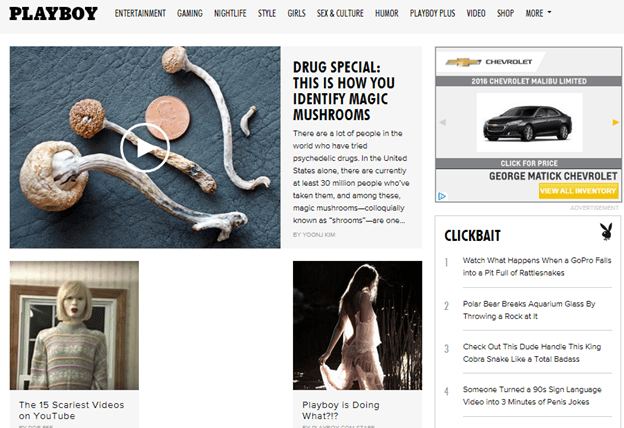By now, you’ve heard the story that after 60 years of colorful pictorials, Playboy is throwing in the towel (sorry) on what was once their unique selling proposition – naked women.

PlayboyIf you’re over 40 and male, you have a Playboy story. Whether it was you and your friend Brad who snuck into his dad’s stash or maybe it was the first time someone in the 5th grade pulled you aside to show you a glimpse of a centerfold, there’s probably an indelible memory.
But now it’s a whole new day. Playboy has decided that it has been the victim of disruption, largely because of the many tentacles of the Internet. What was once mysterious and taboo is now ubiquitous. Web surfers can access pictures of nude people of all genders doing things that are well beyond what they show in the tame pages of Playboy.
In some ways, it’s amazing that it took so long for Playboy to reach this conclusion. But its story has a familiar ring. Many major businesses and brands have felt the sting of disruption – Uber on taxi cabs, Netflix on Blockbuster, Amazon on book stores, and mobile phones on Nikon cameras.
Let’s add radio to the mix because it is being disrupted, too – by streams, podcasts, satellite radio, and pure-plays. And as Mel Robbins writes in a wonderful CNN article about these tectonic moves at Playboy, “The thing that made you famous won’t keep you relevant in a progressive world.”
True that. And yet, stubborn companies in denial about digital’s impact continue to hang onto a status quo that is fading fast. Playboy’s secret sauce – right along with radio’s – was scarcity.
When there were very few places to view high-quality photos of beautiful nude women, Playboy was the central source for this content. And because it was a brand that also featured quality editorial content, there were multiple reasons to flip through its pages. But at the core was the pictures, and once they became commonplace on the World Wide Web, Playboy’s raison d’etre began to deteriorate.
Back in the early ‘90s, we conducted research for Playboy. Even during those days, the nudity was problematic – especially on the sales end of the spectrum. It was easier and safer for media buyers and account managers to reach men via magazines like Esquire and Sports Illustrated. Advertising in Playboy carried risk, sometimes in the form of consumer complaints to CEOs questioning why they’d buy pages in Hugh Hefner’s magazine.
As one of their sales managers asked in a subsequent brainstorm meeting, “Is there a way for us to publish the magazine with less nudity?
At the time, it struck me as a ludicrous question because nudity was what always drove Playboy’s readership. It turns out that this week, he got his wish.
The fact is, Playboy will have to adapt, create and write even better concepts, fiction, interviews, and lifestyle guides. And in many ways, they already have. Robbins points out that Playboy.com is already “safe for work,” and is enjoying massive increases in readership. And an underlying reason for that is without the nudity, the biggest referral engines – Facebook, Twitter, Instagram, and others – are now revved up and humming along. Of course, none of those platforms allows nudity. So now the Playboy brand will hinge its fate on the quality of its editorial content.
So what does this have to do with radio?
Everything. Because that same scarcity model applied to every AM and FM radio station in America. Radio was where you had to go to discover new music, to get traffic and school closing reports, local news, and even humor in the morning.
Today, that content is readily available in many places, often without commercials. And while radio has admirably held onto large portions of its cume reach, younger generations – in particular – aren’t tethered to the terrestrial airwaves. They have moved to on-demand content on myriad devices and screens.
So in many ways, radio strategists have to ask the same questions they’ve been asking at Playboy for years – what is special about our content that people can’t get anywhere else? And what jobs so today’s consumers hire us to do, now that nudity (new music, traffic reports) is available at the click of a mouse, the push of an app, or the swipe of a screen?
 These are healthy questions to ask – now. Because when Playboy was at the top of its game, it sold 7 million copies each month. Today, its monthly circulation is down to 800,000. And even Voltair can’t stop their fall.
These are healthy questions to ask – now. Because when Playboy was at the top of its game, it sold 7 million copies each month. Today, its monthly circulation is down to 800,000. And even Voltair can’t stop their fall.
So the other question I would pose to radio programmers and digital directors as a result of this free marketing lesson from Playboy is what are you going to do with those front page website “Babe of the Day” features you’ve been running for so many years?
Even though they generate considerable page views, what do they say about your brand and what your station is famous for?
When consumers can get this content anywhere, as Playboy learned, what other content could you create and post that would be truly unique and additive to your station brand? As we have long discussed at Jacobs Media, you own your website, so how can you manage and grow that space to enhance your overall station presence in the minds and hearts of your local listening audience.
Playboy is convinced they have enough going as a brand they can jettison the content that made them famous.
Could your station do the same?
- What To Do If Your Radio Station Goes Through A Midlife Crisis - April 25, 2025
- A 2020 Lesson?It Could All Be Gone In A Flash - April 24, 2025
- How AI Can Give Radio Personalities More…PERSONALITY - April 23, 2025





Giving credit when it’s due: This is one of the best metaphors for radio that has ever been written.
Truly appreciative, Ken.
I agree with Ken; great job tying Playboy’s shift to radio’s concerns.
Broadcast offices should be lined with flyers that display your comment, “What is special about our content that people can’t get anywhere else?”
James, that is the intensely tough question that Playboy asked themselves. Very much appreciate your comment.
Fantastic theme here, Fred. Well written, too. Pairs well with a different piece I read recently about utilizing the word “radio” in your station’s brand, so potential Cume know what you are, and also with your post a while back about the power of local radio as manifested by that station off the coast of Madagascar.
If you’re providing good content and you’re local, and your brand is solid, I’m not sure you can lose. Unless Chase Utley takes out your top talent with a vicious slide.
Thanks for the thoughtful comment, Dave. There may not be as many great radio stories as there once were, there are still some amazing brands out there working hard every day.